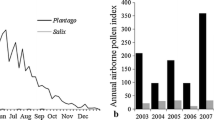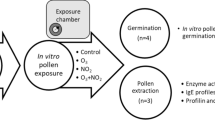Abstract
Atmospheric gaseous pollutants can induce qualitative and quantitative changes in airborne pollen characteristics. In this work, it was investigated the effects of carbon dioxide (CO2) on Acer negundo pollen fertility, protein content, allergenic properties, and carbohydrates. Pollen was collected directly from the anthers and in vitro exposed to three CO2 levels (500, 1000, and 3000 ppm) for 6 and 24 h in an environmental chamber. Pollen fertility was determined using viability and germination assays, total soluble protein was determined with Coomassie Protein Assay Reagent, and the antigenic and allergenic properties were investigated by sodium dodecyl sulfate polyacrylamide gel electrophoresis (SDS-PAGE) and immunological techniques using patients’ sera. Also, pollen fructose, sucrose, and glucose values were determined. Carbon dioxide exposure affected negatively pollen fertility, total soluble protein content, and fructose content. The patient sera revealed increased IgE reactivity to proteins of A. negundo pollen exposed to increasing levels of the pollutant. No changes were detected in the SDS-PAGE protein profiles and in sucrose and glucose levels. Our results indicate that increase in atmospheric CO2 concentrations can have a negative influence of some features of A. negundo airborne pollen that can influence the reproductive processes as well as respiratory pollen allergies in the future.


Similar content being viewed by others
References
Ainsworth EA (2008) Rice production in a changing climate: a meta-analysis of responses to elevated carbon dioxide and elevated ozone concentration. Glob Chang Biol 14:1642–1650
Ainsworth EA, Long SP (2005) What have we learned from 15 years of free-air CO2 enrichment (FACE)? A meta-analytic review of the responses of photosynthesis, canopy. New Phytol 165:351–371
Bist A, Pandit T, Bhatnagar AK, Singh AB (2004) Variability in protein content of pollen of Castor bean (Ricinus communis) before and after exposure to the air pollutants SO2 and NO2. Grana 43:94–100
Blando J, Bielory L, Nguyen V, Diaz R, Jeng HA (2012) Anthropogenic climate change and allergic diseases. Atmos Basel 3:200–212
Bosch-Cano F, Bernard N, Sudre B, Gillet F, Thibaudon M, Richard H, Badot PM, Ruffaldi P (2011) Human exposure to allergenic pollens: a comparison between urban and rural areas. Environ Res 111:619–625
Bradford MM (1976) Rapid and sensitive method for quantitation of microgram quantities of protein utilizing principle of protein-dye binding. Anal Biochem 72:248–254
Chichiricco G, Picozzi P (2007) Reversible inhibition of the pollen germination and the stigma penetration in Crocus vernus ssp vernus (Iridaceae) following fumigations with NO2, CO, and O3 gases. Plant Biol 9:730–735
Clement C, Pacini E (2001) Anther plastids in angiosperms. Bot Rev 67:54–73
Cuinica LG, Abreu I, da Silva JCGE (2014) In vitro exposure of Ostrya carpinifolia and Carpinus betulus pollen to atmospheric levels of CO, O3 and SO2. Environ Sci Pollut Res 21:2256–2262
Dahl Å, Galán C, Hajkova L, Pauling A, Sikoparija B, Smith M, Vokou D (2013) The onset, course and intensity of the pollen season. In: Sofiev M, Bergmann K-C (eds) Allergenic pollen. Springer, Netherlands, pp 29–70
Dlugokencky E, Tans P (2014) NOAA/ESRL (www.esrl.noaa.gov/gmd/ccgg/trends/). Accessed on September 2nd 2014
Dubay DT, Murdy WH (1983) The impact of sulfur-dioxide on plant sexual reproduction—in vivo and in vitro effects compared. J Environ Qual 12:147–149
IPCC (2007) Climate Change 2007: the physical science basis. Contribution of Working Group I to the Fourth Assessment Report of the Intergovernmental Panel on Climate Change, Cambridge University Press, Cambridge, UK
Jackson AV (2003) Sources of air pollution. In: Hewitt JN, Jackson AV (eds) Handbook of atmospheric science: principles and applications. Blackwell Science Ltd, Malden, pp 124–155
Linskens HF, Cresti M (2000) Pollen-allergy as an ecological phenomenon: a review. Plant Biosyst 134:341–352
Majd A, Chehregani A, Moin M, Gholami M, Kohno S, Nabe T, Shariatzade MA (2004) The effects of air pollution on structures, proteins and allergenicity of pollen grains. Aerobiologia 20:111–118
Medlyn B, McMurtrie R (2005) Effects of CO2 on plants at different timescales. In: Baldwin IT et al (eds) A history of atmospheric CO2 and its effects on plants, animals, and ecosystems. Ecological Studies. Springer, New York, pp 441–467
Nepi M, Franchi GG (2000) Cytochemistry of mature angiosperm pollen. Plant Syst Evol 222:45–62
NRC (2010) Advancing the science of climate change. National Research Council, The National Academies Press, Washington, DC
Pacini E (1996) Types and meaning of pollen carbohydrate reserves. Sex Plant Reprod 9:362–366
Parui S, Mondal AK, Mandal S (1998) Protein content and patient skin test sensitivity of the pollen of Argemone mexicana on exposure to SO2. Grana 37:121–124
Rezanejad F (2009) Air pollution effects on structure, proteins and flavonoids in pollen grains of Thuja orientalis L. (Cupressaceae). Grana 48:205–213
Ribeiro H, Duque L, Sousa R, Abreu I (2013) Ozone effects on soluble protein content of Acer negundo, Quercus robur and Platanus spp. pollen. Aerobiologia 29:443–447
Ribeiro H, Duque L, Sousa R, Cruz A, Gomes C, Esteves da Silva J, Abreu I (2014) Changes in the IgE-reacting protein profiles of Acer negundo, Platanus x acerifolia and Quercus robur pollen in response to ozone treatment. Int J Environ Health Res 24(6):515–527
Ring J (2012) Davos declaration: allergy as a global problem. Allergy 67:141–143
Rogers CA, Wayne PM, Macklin EA, Muilenberg ML, Wagner CJ, Epstein PR, Bazzaz FA (2006) Interaction of the onset of spring and elevated atmospheric CO2 on ragweed (Ambrosia artemisiifolia L.) pollen production. Environ Health Perspect 114:865–869
Singer BD, Ziska LH, Frenz DA, Gebhard DE, Straka JG (2005) Increasing Amb a 1 content in common ragweed (Ambrosia artemisiifolia) pollen as a function of rising atmospheric CO2 concentration. Funct Plant Biol 32:667–670
Sofiev M, Belmonte J, Gehrig R, Izquierdo R, Smith M, Dahl Å, Siljamo P (2013) Airborne pollen transport. In: Bergmann K-C (ed) Sofiev M. Allergenic Pollen, Springer Netherlands, pp 127–160
Sousa R, Duque L, Duarte AJ, Gomes CR, Ribeiro H, Cruz A, Esteves Da Silva JCG, Abreu I (2012) In vitro exposure of Acer negundo pollen to atmospheric levels of SO2 and NO2: Effects on allergenicity and germination. Environ Sci Technol 46(4):2406–2412
Taub D (2010) Effects of rising atmospheric concentrations of carbon dioxide on plants. Nat Educ Knowl 3:21
Ziska LH, Beggs PJ (2012) Anthropogenic climate change and allergen exposure: the role of plant biology. J Allergy Clin Immunol 129:27–32
Acknowledgments
This work was funded by the FEDER, COMPETE Program (PEst-OE/CTE/UI0039/2011—UI 39) and Foundation for Science and Technology (PTDC/AAC-AMB/102796/2008). Ribeiro, H. benefits from a scholarship financed by the QREN-POPH and Foundation for Science and Technology (SFRH/BDP/43604/2008).
Author information
Authors and Affiliations
Corresponding author
Additional information
Responsible editor: Philippe Garrigues
Electronic supplementary material
Below is the link to the electronic supplementary material.
Figure S1
(DOCX 2655 kb)
Rights and permissions
About this article
Cite this article
Silva, M., Ribeiro, H., Abreu, I. et al. Effects of CO2 on Acer negundo pollen fertility, protein content, allergenic properties, and carbohydrates. Environ Sci Pollut Res 22, 6904–6911 (2015). https://doi.org/10.1007/s11356-014-3896-2
Received:
Accepted:
Published:
Issue Date:
DOI: https://doi.org/10.1007/s11356-014-3896-2




